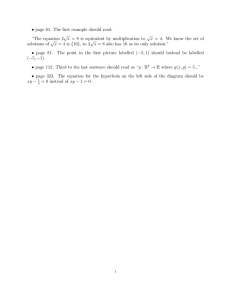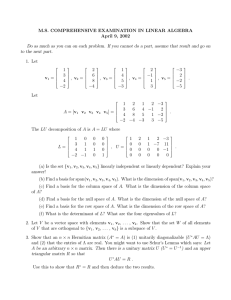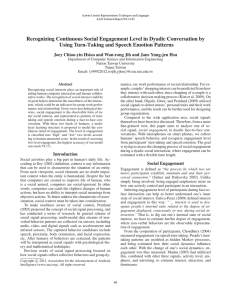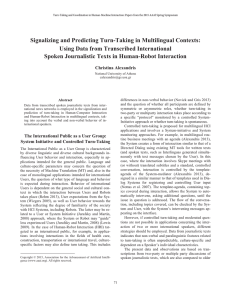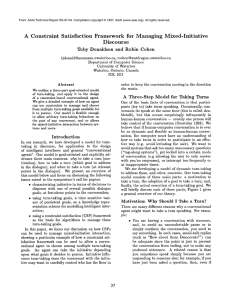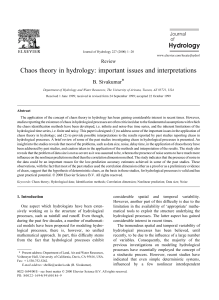2012 BETTER COMMUNICATION
advertisement
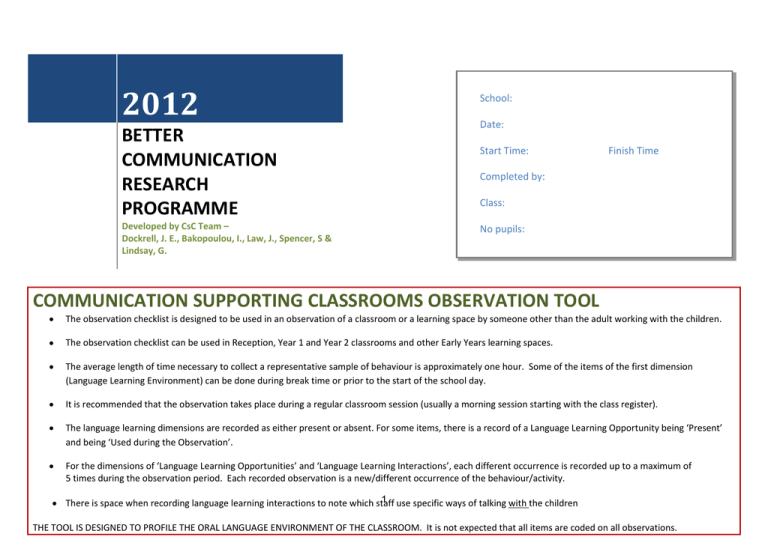
2012 BETTER COMMUNICATION RESEARCH PROGRAMME Developed by CsC Team – Dockrell, J. E., Bakopoulou, I., Law, J., Spencer, S & Lindsay, G. School: Date: Start Time: Finish Time Completed by: Class: No pupils: No staff (excluding observer): COMMUNICATION SUPPORTING CLASSROOMS OBSERVATION TOOL The observation checklist is designed to be used in an observation of a classroom or a learning space by someone other than the adult working with the children. The observation checklist can be used in Reception, Year 1 and Year 2 classrooms and other Early Years learning spaces. The average length of time necessary to collect a representative sample of behaviour is approximately one hour. Some of the items of the first dimension (Language Learning Environment) can be done during break time or prior to the start of the school day. It is recommended that the observation takes place during a regular classroom session (usually a morning session starting with the class register). The language learning dimensions are recorded as either present or absent. For some items, there is a record of a Language Learning Opportunity being ‘Present’ and being ‘Used during the Observation’. For the dimensions of ‘Language Learning Opportunities’ and ‘Language Learning Interactions’, each different occurrence is recorded up to a maximum of 5 times during the observation period. Each recorded observation is a new/different occurrence of the behaviour/activity. 1 use specific ways of talking with the children There is space when recording language learning interactions to note which staff THE TOOL IS DESIGNED TO PROFILE THE ORAL LANGUAGE ENVIRONMENT OF THE CLASSROOM. It is not expected that all items are coded on all observations. LANGUAGE LEARNING ENVIRONMENT: This dimension involves the physical environment and learning context NOT SEEN OBSERVED 1 2 3 4 The classroom is organised to emphasise open space. Learning areas are clearly defined throughout the classroom. Learning areas are clearly labelled with pictures/words throughout the classroom. Space for privacy/ quiet areas where children can retreat to have ‘down time’ or engage in smaller group activities. These areas are less visually distracting. 5 Children’s own work is displayed and labelled appropriately. 6 Some classroom displays include items that invite comments from children. 7 Book specific areas are available. 8 Literacy specific areas are available 9 Background noise levels are managed consistently throughout the observation, and children and adults are able to hear one another with ease. 10 Transition times are managed effectively, so that noise levels are not excessive and children know what to expect next. 11 There is good light. 12 The majority of learning resources and materials are labelled with pictures/words. 13 Resources that are available for free play are easily reached by the children or easily within their line of vision. 14 An appropriate range of books is available in the book area (e.g, traditional stories, bilingual/dual language books and a variety of genres and books related to children’s own experiences). 15 Non-fiction books, books on specific topics or interests of the children are also available in other learning areas. 16 Outdoor play (if available) includes imaginative role play. 17 Good quality toys, small world objects and real / natural resources are available. 18 Musical instruments and noise makers are available. 19 Role play area is available. TOTAL /19 NOTES LLE SCORE 2 Present: Used: Present: Present: Used: Used: COMMENTS LANGUAGE LEARNINGOPPORTUNITIES: This dimension involves the structured opportunities that are present in the classroom to support language development Not Seen 1 Small group work facilitated by an adult takes place. 2 Children have opportunities to engage in interactive book reading facilitated by an adult (for example: asking predictive questions, joining in with repetitions, story packs etc.). Children have opportunities to engage in structured conversations with teachers and other adults. 3 4 Children have opportunities to engage in structured conversations with peers (Talking partners). 5 Attempts are made to actively include all children in small group activities. TOTAL LLO SCORE: /25 NOTES: 3 Observed (5 times) Comments LANGUAGE LEARNING INTERACTIONS: This dimension involves the ways in which adults in the setting talk with children. Not Seen 1 Adults use children’s name, draw attention of children. 2 Adults get down to the child’s level when interacting with them. 3 Natural gestures and some key word signing are used in interactions with children. 4 Adults use symbols, pictures and props (real objects) to reinforce language. 5 Pacing: Adult uses a slow pace during conversation; give children plenty of time to respond and take turns in interacting with them. Pausing: Adult pauses expectantly and frequently during interactions with children to encourage their turn-taking and active participation. Confirming: Adult responds to the majority of child utterances by confirming understanding of the child’s intentions. Adult does not ignore child’s communicative bids. Imitating: Adult imitates and repeats what child says more or less exactly. 6 7 8 9 Commenting: Adult comments on what is happening or what children are doing at that time. 10 Extending: Adult repeats what child says and adds a small amount of syntactic or semantic information. 4 Observed Observed By All Staff in Classroom COMMENTS 11 Labelling: Adult provides the labels for familiar and unfamiliar actions, objects, or abstractions (e.g. feelings). 12 Adult encourages children to use new words in their own talking. Open questioning: Adult asks open-ended questions that extend children’s thinking (what, where, when, how & why questions). Scripting: Adult provides a routine to the child for representing an activity (e.g. First, you go up to the counter. Then you say ‘I want milk..’) and engages the child in known routines (e.g. ‘Now it is time for circle time. What do we do first?’). Adult provides children with choices (for example: ‘Would you like to read a story or play on the computer?’). 13 14 15 16 Adult uses contrasts that highlight differences in lexical items and in syntactic structures. 17 Adult models language that the children are not producing yet. 18 Turn-taking is encouraged. 19 Children’s listening skills are praised. 20 Children’s non-verbal communication is praised. TOTAL LLI SCORE: /100 NOTES: This tool was developed as part of the Better Communication Research Programme 2012 5
